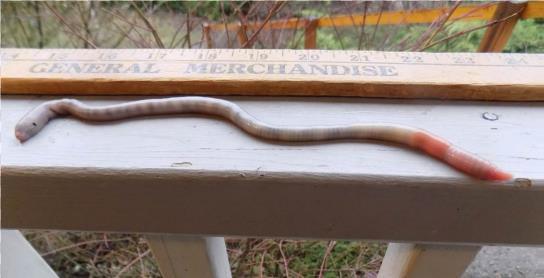Low-
Moderate
The population size of giant Palouse earthworm is unknown. Data on this species are sparse. The species is difficult to detect and few surveys have been performed to determine its distribution and abundance. There has been an obvious reduction of its range in the Palouse region of Washington with the conversion of prairie to cropland. Additionally, introduced worm species appear to exclude native worm species, including this one.
Description and Range
Physical description
The giant Palouse earthworm is a large pale or white earthworm.
Ecology and life history
This species has, until relatively recently, been considered endemic to the Palouse prairies of eastern Washington and Idaho, where it was discovered in 1897. This species is considered to be “anecic”, meaning that it burrows vertically deep into the ground and lives in deep, semi-permanent burrows, coming to the surface in wet conditions. Burrows have been found at a depth of 15 feet.
Originally assumed to require deep, loamy soils characteristic of the Palouse bunchgrass prairies, the species was found in the eastern Cascades occupying gravelly sandy loam and other rocky soils in forested areas. They have been found in open forest, shrubsteppe, and prairie. Of sites surveyed, only one occurrence was in non-native vegetation on land enrolled in the Conservation Reserve Program.
The giant Palouse earthworm feeds on fresh plant litter.
Anecic worms are the largest and longest lived of the three general groups of earthworms.
Geographic range
In Washington, the giant Palouse earthworm has been found in Chelan, Kittitas and Whitman Counties. It may be more widespread because recent records from the east slope of the Cascades have expanded its known range. Based on knowledge of other species in the Megascolecidae family to which this species belongs, the worm’s range could extend along the Columbia Plateau in a band just below the terminal moraines of the Pleistocene glaciation. Because these worms are very slow colonists, range limits are probably determined by the extent of Pleistocene glaciation and the Missoula Floods, both of which would have eliminated earthworms.
For maps of this species’ range-wide distribution and conservation status information, check out the NatureServe Explorer and International Union for Conservation of Nature‘s Red List.
Climate vulnerability
Sensitivity to climate change
Low
There is little information on the sensitivity of the giant Palouse earthworm (GPE) to climate change, largely due to the fact that very little is known about this species in general. The GPE likely exhibits sensitivity to temperature; it can experience mortality from high soil temperatures, and utilizes deep burrows to survive hot, dry summer periods. Increasing temperatures and increasingly xeric conditions may reinforce this behavior. The GPE may also be sensitive to precipitation shifts and fire, as these regimes affect vegetative cover and can modify microhabitat and soil conditions, but links between precipitation, disturbance, vegetation, and GPE abundance are not clear at this time.
Exposure to climate change
Moderate-
High
- Increased temperatures
- Reduced soil moisture
Conservation
Conservation Threats and Actions Needed
- Agriculture and aquaculture side effects
- Threat: In the Palouse region, plowing and soil disturbance due to agricultural activity has converted giant Palouse earthworm habitat.
- Action Needed: Surveys are needed in undisturbed areas to determine site occupancy.
- Resource information collection needs.
- Threat: Originally found in Palouse prairie and thought to be endemic there, but recent detections in the East Cascades and clues regarding range characteristics indicate the need for greater survey efforts.
- Action Needed: Past surveys have been conducted in the Palouse region. East Cascades detections were accidental at first. Very limited, spot surveys done since.
- Threat: Questions remain regarding possible genetic differences between the Palouse and East Cascade populations.
- Action Needed: Research on genetics being done by J. Johnson-Maynard at the University of Idaho. Results not definitive.
- Fish and wildlife habitat loss or degradation
- Threat: Washington State Department of Transportation and U.S. Fish and Wildlife road building and alternation have disrupted earthworm concentrations. This is how they were discovered in the East Cascades.
- Action Needed: Review of proposed transportation projects.
- Invasive and other problematic species
- Threat: Invasive, non-native earthworm species, notably the European earthworm (Lumbricus terrestris).
- Action Needed: Note occurrences and continue surveys.
See the Climate vulnerability section above for detailed information about the threats posed by climate change to this species.
Resources
References
USFWS. 2011. Endangered and Threatened Wildlife and Plants; 12-Month Finding on a Petition to List the Giant Palouse Earthworm (Driloleirus americanus) as Threatened or Endangered. Federal Register 76(143):44547- 44564.
J. Fleckenstein, Washington Department of Natural Resources, personal communication
J. Maynard-Johnson, University of Idaho, personal communication
K. McAllister, Washington State Department of Transportation, personal communication
